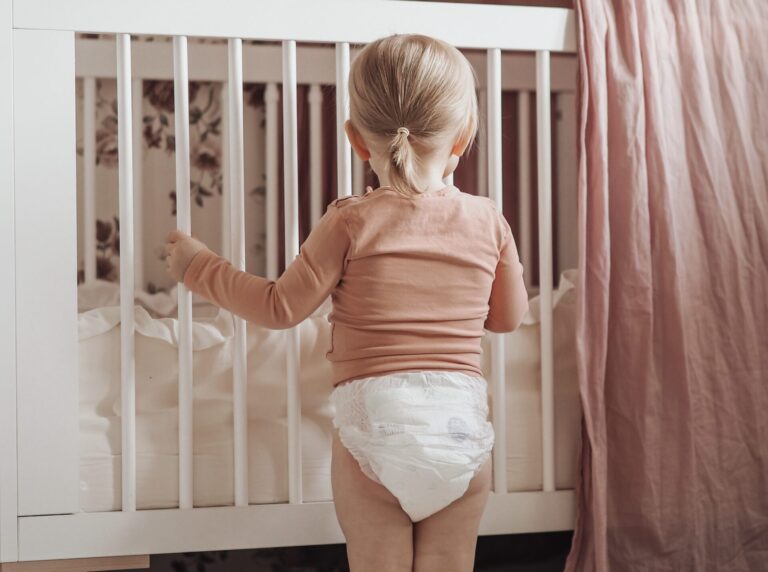The first few months are a period of true growth and development, and sleep is a very important factor in this process. Sleep provides your baby with essential time to rest and grow. But what actually happens during these important sleep phases? In this article, we take a look at babies’ sleep cycles, explain how they are structured and why they are so essential for your baby’s well-being. It is particularly important to understand and support these sleep cycles to ensure that babies get the rest and support they need for growth and development.
Why are a baby’s sleep cycles different from an adult’s?
The nature of a baby’s sleep is very different from that of an adult, and this is an important point that parents should understand. The sleep cycle of a newborn consists mainly of rapid eye movement (REM) sleep, which is crucial for brain development. In adults, on the other hand, sleep is more evenly split between REM and deep sleep (NREM).
The sleep cycle of an adult lasts about 90 minutes, while that of a baby is shorter, around 45-50 minutes. This explains why babies may wake up more often and sleep more lightly, because their sleep cycles are shorter and they have a higher REM sleep rate. As a result, babies need several short sleep cycles around the clock. In addition, babies’ sleep and awake rhythms do not yet follow a regular circadian rhythm because their internal clock is still developing. Understanding these differences is key to supporting your baby’s natural sleep rhythm and promoting their well-being and healthy development.
Stages of baby sleep: The difference between REM and NREM sleep
Knowing and understanding your baby’s sleep stages is an essential part of supporting your baby’s wellbeing. Babies’ sleep is mainly composed of two basic types: rapid eye movement (REM) sleep and non-rapid eye movement (NREM) sleep. The key difference between the two is that REM sleep plays an important role in brain development. This is a period of intense dreaming and the baby’s brain processes what it has learned during the day. On the other hand, NREM sleep is divided into several levels of depth. It is important for physical recovery and growth, as the body repairs and rebuilds its tissues during this phase.
The stages of sleep in a baby are significantly different from those in an adult. Babies have a much higher proportion of REM sleep than adults, and they move more quickly between REM and NREM. This makes babies’ sleep cycles shorter and more shallow. As a result, newborns may wake up more frequently during the night. However, over time, as the baby grows and brain development progresses, the ratio of sleep stages slowly starts to more closely resemble adult sleep cycles, and night sleep becomes longer. By understanding these natural stages of sleep, parents can better regulate sleep routines and support healthy sleep development in their baby.
Find out more about newborn’s sleep here!
Development of sleep cycles: From baby to toddler
The development of sleep cycles starts as early as a newborn and continues through the baby and toddler years. Initially, a baby’s sleep cycles are very different from those of older children or adults. During the first few months of life, babies spend more time in REM sleep, which is important for rapid brain development. However, as a child grows and their brain function develops, their sleep cycles also change. Around 3-6 months of age, babies start to sleep longer periods at night, and the duration of sleep cycles and their components – REM and NREM sleep – start to more closely resemble the structure of adult sleep cycles.
Around six months of age, babies may start sleeping through the night without feeding, and their sleep will increasingly consist of deep NREM sleep. By this time, the baby’s internal clock, or circadian rhythm, has also developed, helping them to distinguish between day and night. This means that the ratio of night sleep to day sleep is changing, and the baby is likely to need less sleep during the day. Establishing a regular sleep rhythm is important because it ensures that your baby gets enough rest at critical times for growth and development. It is important to remember that each baby is an individual and there may be differences in the development of sleep cycles.
Here are expert tips on how to improve your six-month-old’s sleep!
Experts recommend that parents should wait a while before going to the baby to give the baby a chance to learn to fall asleep independently.
Natural wake-ups: A normal part of your baby’s sleep cycles
Natural wake-ups are an important and normal part of your baby’s sleep rhythm. Babies usually sleep in short periods and may wake several times a night. This is because their sleep cycles are shorter than adults, lasting around 30-50 minutes. In between these sleep cycles, the baby may fully wake up or be partially awake. It is important for parents to understand that these short wake-up periods are normal, especially after the lighter REM sleep phase.
The baby may cry or make noises when they wake up, but they often go back to sleep without the parents’ help. This ability to settle back to sleep is an important skill that babies learn over time. Parents should provide a comforting and safe environment so that the baby learns to calm down on their own. Experts recommend that parents should wait a while before going to the baby to give the baby a chance to learn to fall asleep independently. However, if the baby is clearly very agitated and not calming down on its own, parents should definitely comfort it. Accepting and managing natural wakings can help both baby and parents to get better sleep in the long run.

The importance of baby’s sleep for growth and development
Your baby’s sleep is extremely important for their physical growth and cognitive development. During sleep, a baby’s body produces growth hormone, which promotes muscle and bone growth and helps the body repair and regenerate tissues. Sleep also plays a key role in brain function, supporting memory, learning and mental health. Research shows that adequate sleep can improve a baby’s mood and reduce anxiety, which is important for their emotional control.
Especially during REM sleep, which is more common in babies than adults, synapses are formed, which is vital for brain development. This helps the baby’s nervous system to develop and learn new skills. Lack of sleep or poor quality sleep can lead to developmental delays and learning difficulties. Naps also play an important role in a baby’s well-being, helping them to process new information and reinforce learning and memory development.
Parents should try to support good sleep by creating regular bedtimes, peaceful sleeping environments and avoiding overly active activities before bedtime. Supporting a baby’s sleep in the first months of life not only promotes health and well-being, but also lays the foundation for healthy sleep and development later in life.
Read more about baby’s sleep at 1 month here!
Tips to support your baby’s sleep rhythm
Regularity and predictability are key to supporting your baby’s good sleep rhythm. This means that your baby’s bedtime should be roughly the same every night and sleep routines such as bathing, changing into nightclothes and bedtime stories should be repeated in the same order. These routines help your baby to relax and recognise that it is time to get ready for bed. Also pay attention to the timing and duration of your baby’s naps so that they are not overstimulated or too tired before bedtime.
The baby’s sleeping environment should be calm, quiet and as dark as possible, so that distractions do not disrupt the baby’s sleep rhythm. Avoid exposing your baby to excessive distractions before bedtime, such as loud music or watching a TV screen, as these can stimulate your baby and make it harder for them to fall asleep. You can use a soft night light near the bed or play quiet music or white noise to help calm the baby.
Babies often calm down when touched, so gentle caressing can help them prepare for a good night’s sleep. It is important to maintain a calm and consistent approach to support your baby’s sleep rhythm. This will help them learn to trust routines and feel secure. When trying to adjust your baby’s sleep rhythm and support their natural sleep needs, patience is key.
Sleep school can be challenging and require patience from parents.
Sleep school: When and how can it be used?
Sleep school can be a useful way to teach babies the skills needed to sleep independently and to sleep through the night. Generally, this process can be considered around 4-6 months of age, when the baby is ready to sleep for longer periods without waking and has established some kind of natural sleep rhythm. However, before starting sleep training, it is important to ensure that the baby is healthy and that parents are prepared to commit to a consistent and calm approach to the teaching method.
There are different approaches to sleep school, and parents should choose the one they feel is most fitting and best suited to their child’s temperament. Some popular methods include ‘crying’ methods, such as the Ferber method, where the baby is allowed to cry at certain times before being comforted by the parent, and the ‘no crying’ method, where parents gradually reduce their presence during the baby’s bedtime routine.
Whatever method you choose, it is important to establish a regular bedtime routine and ensure that your baby’s sleep environment is soothing and supportive of sleep. Although sleep school can be challenging and require patience from parents, it is designed to help the baby and family achieve better and more restful sleep quality in the long term.
Read more about sleep school here!
The role of the parent: This is how you can help your baby sleep better
The role of the parents in supporting the baby’s sleep rhythm is very important. This is because babies learn from daily activities and routines that are consistently carried out by parents. Parents can help babies to distinguish between daytime and nighttime sleep by clear actions such as darkening the room during nighttime sleep and keeping the light on during the day. By establishing a regular and calm bedtime routine, such as an evening bath, diaper change, a calm recap of the day’s events and a possible singing or story time, the baby learns to calm down and prepare for sleep.
It is also important for parents to react sensitively but calmly to their baby’s crying and discomfort. If the baby wakes up and cries in the night, parents should wait a while before comforting them. This gives the baby a chance to learn to soothe themself back to sleep. It is important to understand that each baby is an individual and sleep needs may differ. Parents should adapt their actions according to the baby’s needs and reactions, and sometimes it may be helpful to seek professional advice or support on sleep school. With a balanced and understanding approach, parents can support their baby’s well-being and promote healthy sleep rhythms, which are essential for the child’s overall growth and development.
More tips for better sleep for your baby can be found here!
How do Moomin Baby diapers support your baby’s sleep cycles?
Finnish Moomin Baby diapers are designed to support babies’ sleep cycles in many ways. Firstly, these high-quality diapers provide reliable protection during the night. They absorb moisture effectively and keep baby’s skin dry, helping to prevent possible wake-ups from feeling wet. This allows for a more uninterrupted and deeper sleep, while promoting baby’s development and growth.
Secondly, Moomin Baby diapers are breathable, which helps prevent diaper rash that can disturb your baby’s sleep. A high quality diaper effectively absorbs moisture and keeps it away from the skin, reducing the risk of skin irritation.
We welcome you to try Moomin Baby diapers by ordering your free Diaper Hero sample here!










